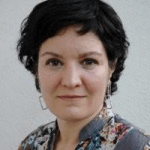Diana Pascual or life through the forest
Being one of the few female forestry engineers at CREAF and having come from environmental consultancy and hydraulic modelling gives Diana Pascual a unique profile. Hers is a trajectory of courageous decisions often taken based on intuition, such as getting involved in research projects from a professional profile markedly oriented towards the knowledge transfer. “I never thought I would work in science, I was going straight to business”, she exclaims, while recalling that her background in river modelling to assess flood risks due to climate change was key to joining CREAF's ACCUA project 15 years ago. She then contributed to the LIFE MEDACC project, joined the centre's specialised water research group and every day consolidates the intimate desire to make the environment the protagonist of his professional dedication. “My relationship with nature is very intense, it is one of the best experiences I have”, she recalls.
I never thought I would work in science, I was going straight to business.
She eloquently explains that water is a sort of “a flowing vector” in her professional dedication, oriented towards knowledge transfer to inform both political action and many technical decisions, for example, of forest ownership communities. “I've always felt that my dedication to scientific knowledge transfer is very deep-rooted, very visual and allows for a lot of application and replication”, she says.

She thinks fast and expresses herself with great agility, as if she were certain that it is convenient to store the maximum amount of information in a finite period. And she gives such a wealth of information that, when you react, she explains why she felt so comfortable studying technical forestry engineering at the University of Valladolid and then higher education at the University of Lleida; the subsequent scholarships she obtained to study in the United States, Belgium and Hungary and the voluntary work for organisations such as a forestry school in Colombia and a cooperation project on human rights and water in El Salvador. “The university was one of the best experiences I have had, the opportunity it gave me has also contributed to who I am. And, in addition, Forestry Engineering is beautiful because you learn how ecosystems work, you learn to identify plant and animal species, you understand nature procedures... It must be said that the engineering part is hard, but it was very fulfilling for me: I really like numbers, I have a knack for making calculations and I enjoy playing with them”, she recalls.
An engineer’s mind
The transfer of scientific knowledge to which Diana Pascual is dedicated supports science, as she herself says. “I am more involved in knowledge transfer than in science, because the results of my work are more applicable to forestry management and livestock and land ownership, for example, than to science”, she clarifies. “I contribute to science, and I design and promote many forest management experiments in the field, measuring, applying scientific criteria... obviously, so that the results can be applied and are consistent”. One of the main results of her dedication is to inform public policy making from a scientifically rigorous point of view.

“I have always thought my dedication to the transfer of scientific knowledge is deeply rooted, very visual and allows for a lot of application and replication"
DIANA PASCUAL SÁNCHEZ, CREAF research officer
One of the main consequences is that she publishes in informative journals, intervenes in the drafting of manuals and position papers addressed, for example, to the European Commission, and shares results in seminars and talks, to name but a few. She admits that in the past she felt the weight of a certain self-pressure to publish scientific articles and that she even considered enrolling in PhD courses: “I don't rule it out in the future, I don't rule it out...”, she says. Although she emphasises that she had never thought of a career in science.
And she closes with a gentle forcefulness that is characteristic, to explain how she moves through the scientific environment, still quite hierarchical: “I don’t feel like an intruder. I don’t experience impostor syndrome at all: I have my head furnished more like an engineer than a scientist. And, therefore, I let myself be carried away by practical and applied things and I don’t feel so comfortable writing scientific articles. Today I feel more at home speaking at a transfer talk, than at a scientific conference.”
A 4-handed work
Suddenly she switches to the plural and never left it again: this is when she speaks of her collaboration side by side with CREAF researcher Eduard Pla, with whom she shares proposals, field work, the design of experiments in the field, hours of analysis and the search for solutions from the very first day she set foot in the centre. We can speak of a professional tandem consolidated on the axis of involvement and work capacity.

Over the course of 15 years, the focus of their collaboration has been evolving, although water, forests, forest management, drought and climate change have always been on the table. In their field of knowledge about forests and adaptation to climate change, they are incorporating aspects of socioeconomic viability. "Eduard Pla and I have introduced the variable of extensive livestock farming, to have more carbon in the soil, maintain the effect of forest management over time and improve pastures and biodiversity", she explains. “We talk a lot about the concept of mosaic landscapes, to provide different uses and services, reduce the risk of fire and improve biodiversity, and we study it from experimental plots, in a work with 200 people in Girona, Huesca and La Rioja. One of the wills is that the mountain pastoral systems reach the European Commission and can be transformed into policies." This is, in fact, one of the requirements of the Commission in the Life research projects.
The forest runs through her life and her latest move has taken her to the most forested province in Spain, Soria, to settle in a small mountain village. Her initial desire was to move closer to her family and the most radical consequence was to live in a village of 50 inhabitants. “We haven’t thought about it much”, she admits without regret. “I have been renting for more than 20 years and I wanted to have the freedom to go where the movements take me. I am not afraid of these changes”.







